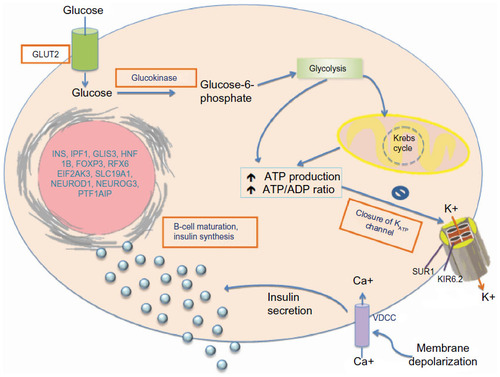Figures & data
Table 1 Known genetic mutations causing transient and permanent neonatal diabetes mellitus
Figure 1 Pancreatic beta cell depicting the role of genetic defects in neonatal diabetes mellitus.
Notes: Numerous intricate steps are implicated in insulin release by the B-cell, in response to glucose, as shown in the figure. The genes illustrated in the nucleus and boxed elements (such as closure of the KATP channel) are necessary for normal function and serve as potential points of defect that can lead to inadequate insulin synthesis and/or release. Although neonatal diabetes is a common outcome, the severity of symptoms and other associated features are dependent on the underlying genetic etiology.
Abbreviations: ADP, adenosine diphosphate; AIP aryl hydrocarbon receptor interacting protein; ATP, adenosine triphosphate; EIF2AK3, eukaryotic translation initiation factor 2-alpha kinase; FOXP3, forkhead box P3 protein; GLIS3, Gli-similar 3 protein (zinc finger protein); GLUT2, glucose transporter 2; HNF-1B, hepatocyte nuclear factor-1-beta; INS, insulin; IPF1, insulin promoter factor; KATP, ATP-sensitive potassium channel; NEUROD1, neuronal differentiation 1; NEUROG3, neurogenin-3; PTF1, pancreas transcription factor; RFX6, regulatory factor X 6; SLC19A1, solute carrier (thiamine transporter); SUR1, sulfonylurea receptor; KIR6.2, ATP-sensitive inward rectifier potassium channel.
Abbreviations: ADP, adenosine diphosphate; AIP aryl hydrocarbon receptor interacting protein; ATP, adenosine triphosphate; EIF2AK3, eukaryotic translation initiation factor 2-alpha kinase; FOXP3, forkhead box P3 protein; GLIS3, Gli-similar 3 protein (zinc finger protein); GLUT2, glucose transporter 2; HNF-1B, hepatocyte nuclear factor-1-beta; INS, insulin; IPF1, insulin promoter factor; KATP, ATP-sensitive potassium channel; NEUROD1, neuronal differentiation 1; NEUROG3, neurogenin-3; PTF1, pancreas transcription factor; RFX6, regulatory factor X 6; SLC19A1, solute carrier (thiamine transporter); SUR1, sulfonylurea receptor; KIR6.2, ATP-sensitive inward rectifier potassium channel.

